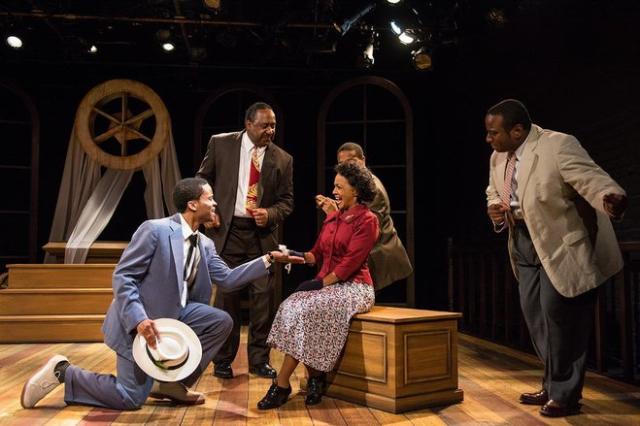
Drawn from the headlines of 1955, The Ballad of Emmett Till does far more than recreate the facts of how an innocent young boy died and possibly ignited America’s civil rights movement. Playwright Ifa Bayeza uses creative, storytelling techniques (hence the term “Ballad” in the show’s title) to describe the horrifying murder of Emmett Till.
Till was a 14-year-old black boy who died at the hands of cruel white men in rural Mississippi. Those in the audience may recall hearing about Emmett Till from their high school civics class. If they did hear the name at all, what most people recall is his death. This play brings the character of Emmett Till to life.
The Ballad of Emmett Till had its world premiere several years ago at Chicago’s Goodman Theater. It has been staged a number of times since then. The production at Renaissance Theaterworks is the show’s Milwaukee debut. It’s clear that Milwaukee-based director Marti Gobel had a clear vision of her goals for this production. She says in the program notes that she wants the audience to get to know Emmett while he was alive – not just for the circumstances leading to his death. Thanks to the excellent casting of Marques Causey as Till, the show is both lively and gut-wrenching. It starts out with a ballad (not the one by a very young Bob Dylan) that tells the tale of Till’s death. Along with Till, the story emphasizes the warm, loving family that surrounded him. His mother, especially, played a major role in Till’s upbringing. In the play, Emmett (called Bo by most who knew him) is presented as a complex character. He is an entertainer by nature and often gets his way (especially with his mother) with a quick dance step, a smile, and a wave of his white fedora. A childhood injury left him with a stutter. However, despite his cousins’ teasings about his speech impediment, Till refused to let them get the better of him. He was a force that could not stay quiet. It seems that Till was quite a dresser, even at age 14. Costume designer Leslie Vaglica transports us into the 1950s with her period outfits. Although not all of them are designed to be as spiffy as Emmett’s wardrobe, they help convey the contrast between big-city life (Chicago) and the deep South (Mississippi).
A trio of musicians (unseen behind the stage) help to deflect one’s attention from the grim conclusion to Emmett Till. The musicians’ tunes alternate between jazz, gospel and folk music.
Causey, who is smiling. charming and mischievous, is also full of the invincibility of youth. He sees the South as a place to be conquered, and he can hardly keep still on his first train ride out of town. Yet he also predicts in the opening sequence that his life would “be short, but not uneventful.” Still, he has no clue that this first out-of-town adventure would be his last. The entire cast of six does an excellent job of jumping in and out of multiple roles as they tell Till’s story. Allen D. Edge, playing the strong older uncle who runs a Mississippi farm, is excellent in his quest to “make a man” out of his nephew. He talks about why he stays in the south to plow his family’s land. In this inspiring speech, he portrays a strong and hard-working man.
But later, when faced by angry white men who demand to see Till, Edge also does a great job of playing an Uncle Tom who tries every option to keep the men from taking the boy. He willingly sacrifices his pride for his family. He fears what could happen if the men get their hands on Till (and rightly so).
Till’s fate is foreshadowed in a number of ways. The set is one of them. The unmistakable shape of a coffin is permanently onstage. It is used for various purposes, such as a trunk that holds props and also a kitchen table. It visually reminds the audience of the closeness this story has to death.
Gobel uses clever and creative ways to represent elements of the story. A simple, long white glove on the hand of a black woman indicates the “white” character she is assuming. The all-black cast uses such devices when creating “white” characters. At the same time, they turn their bodies away from the audience. Does this indicate the faceless but powerful white society?
This reviewer’s only quibble is the directorial decision to turn Till into a Christ-like figure. After his brutal murder, Till seemingly rises from the dead. In doing so, he emerges—arms outstretched—from white, gauzy panels of fabric. A more subtle approach (such as the white-gloved woman) may have gotten the message across without resorting to such obvious parallels.
It is said that Till’s death played a role in the civil rights movement by unifying the black community. The sight of Till’s unrecognizable face (his mother insisted on an open coffin) and the later acquittal of his murderers undoubtedly fueled the growing rage of America’s black population. However, the play doesn’t deal with the aftermath of Till’s funeral. It ends with a final statement from Till that says, basically, his death was not in vain.
